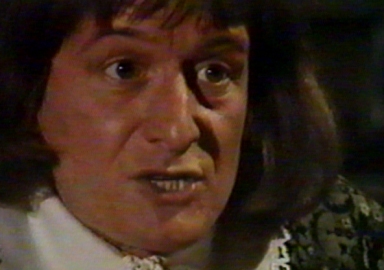

|
‘The Roses of Eyam’ |
   |

The story of the Eyam plague was dramatised on the small screen in the early 1970s, when writer-director Don Taylor adapted his successful stage play for television. The Roses of Eyam was broadcast on BBC2 on 12 June 1973, between 9pm-11.05pm. As a TV director, Taylor had a solid background at the BBC, having, for example, directed installments of the Wednesday Play, (Dan, Dan, The Charity Man, 3 February 1965; And Did Those Feet?, 2 June 1965). Taylor had then left the BBC, to concentrate on his work in the theatre, as both a director and a writer. Taylor's first production of The Roses of Eyam had its world premiere at The Northcott Theatre in Exeter, Devon on 23 September 1970. Tayor returned to television, directing a version of his own The Exorcism (for Dead of Night) in 1972, and The Roses of Eyam the following year. Survivors scriptwriter Don Shaw recalls that, prior to his work on the second series of Survivors: 'my agent rang me from London and said "Don, you live in Derbyshire, why aren't you writing something about the plague at Eyam?"' Shaw was actively considering the idea when he discovered that: 'Lo and behold, as so often happens in this world, two minds think alike and it was being done, it was already being produced, with Don Taylor directing it.' The Roses of Eyam was made by BBC Birmingham, and produced by David Rose. The designer was Michael Edwards, with period costumes provided by Joyce Hawkins, and make-up by Jan Nethercott. Music was composed by Herbert Chappell. The Roses of Eyam was repeated on BBC2 on 29 January 1974 between 7.35pm and 9.40pm.
CommentaryThe Roses of Eyam is a powerful and affecting television drama, dominated by a tour de force performance by Ronald Pickup in the lead role of the Reverend William Mompesson. Taylor's script, adapted from his own stage play, does introduce some dramatic contrivances, yet is in large part true to the central elements of the real-life history of the Eyam plague. Most of the accepted 'key' moments of that history are dramatised — the arrival in the village of the George Vicars' infected cloth; the first deaths and the spread of the contagion; the agreement on the quarantine; the growing death count; the open-air church services; Catherine Mompesson's own tragic fate, and, finally, the plague's passing, and the surviving villagers' resilience. Above and beyond this recounting of the historical record, Taylor makes considerable efforts to characterise and humanise those confronted by the horrors of the plague, not content to have them remain as little more than ciphers or statistics. Taylor also makes time to explore the theological conflicts that initially pit Mompesson against Thomas Stanley, and depicts their alliance over the quarantine as a fraught and awkward one. In Taylor's script, and in Pickup's depiction, William Mompesson emerges as a flawed and human hero, rather than some abstract spiritual saint. Although his public demeanour is one of fortitude, resilience and religious conviction, he is in private torn by self-doubt and feelings of inadequacy and irrelevance, and humbled by his own sense of moral imperfection.
On the small screen, The Roses of Eyam retains many of the elements of its earlier theatrical realisation. Although a small number of leading characters dominate the story, in demonstrating the impact of the plague upon the village, the play requires a large ensemble cast, grouped into families or with specific roles within the community. Taylor chooses a strongly theatrical style of staging and direction, with the company composed on screen in often stage-like ways, and with a preference for long single-take scenes. What reinforces this theatrical ambience still further is that the entire of the drama is staged on a vast studio set — compromising the main village square, the churchyard, the Delph open-air church; as well as all of the interiors in which the fate of Eyam's families is depicted.
Note: Copyright on the images used here is held by the BBC, and no infringement of that copyright is intended. The images are displayed here for the non-profit enjoyment of fans only.
Mad Dog > Derbyshire's 'plague village' >
Page last updated: |
||||||||||||||